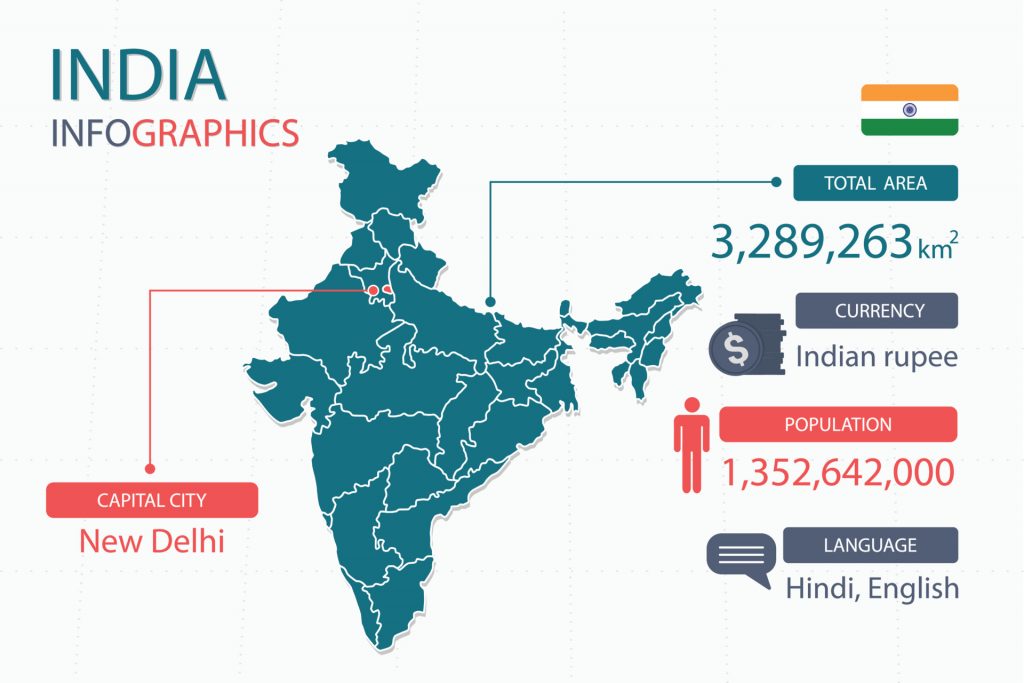The origins of the Punjabi Language
Punjabi is a major language in the countries of India and Pakistan and has been historically associated with the Punjab region. 122 million speakers claim to speak Punjabi as a native language, making it the 10th most widely spoken language in the world. In India itself, it became an official language in 1947 and is one of the 22 scheduled languages of India. On the broader Indian sub-continent, it is the third-most spoken language, and in Pakistan, it is the most widely used language, despite Standard Urdu being the main official language in terms of government and education. Outside the Indian sub-continent, there is a significant amount of speakers because of Indian ethnic communities that reside in parts of the United States, Australia, Canada, and the United Arab Emirates.
Punjabi is unique among many Indic languages because it contains lexical tone, with three in total. That is, a word that has the same vowel and consonant combinations can change meaning when it is expressed in a different melody. This is comparable to many Chinese languages, Thai, and Lao. Another unique aspect of Punjabi, especially to those who are used to more Western languages, is that it employs more than one writing system. Currently, both the Shahmukhi and Gurmukhi script are used to write Punjabi, with the former one preferred by Muslims who speak it, while the later one is preferred by Sikhs and Hindus.
In terms of grammatical features, it is a language that generally follows subject-object-verb pattern in its sentences and contains post-positions to indicate meanings of space (in, on, at), not unlike other related languages.

Punjabi is an Indo-Aryan language, originally derived from Sanskrit. Sanskrit originally was a source of many of the Prakrit languages that followed it, and Punjabi can be considered an offspring of these languages. Specifically, its origins are from one Prakrit variety called Shauraseni Prakrit. In addition to its Sanskrit roots, Punjabi also exhibits a heavy Arabic and Persian influence, mainly from the Muslim conquests and rule from the past. This is especially prominent in its vocabulary. Most recently, there is also notable influence from Portuguese and English, mainly due to the history of colonialism that has occurred on the Indian subcontinent.
As mentioned above, two writing systems are used for Punjabi. One script is called Gurmukhi, which is a Brahmic script. Literally, Gurkmukhi means ‘the guru’s mouth.’ The second one is called Shahmukukhi, an Arabic-based script, meaning ‘the King’s mouth,’ most likely stemming from the time of Sultanate rule. These historical circumstances also explain the reason behind a preference for Gurkmukhi with Hindu populations as opposed to Shahmukuhi for Muslim communities, even though they both use the same language. Moreover, Gurkmukhi tends to be used more in Indian states, while Shahmukukhi is more widely used in Pakistani regions.
The first writing system, Gurkmukhi is a modified Sikh script. It is an abugida, with consonants being the main components and vowel symbols modifying a natural sound that the consonants already possess. In this script, there are 38 consonants, 10 vowels, and symbols for nasal sounds (such as the -n or -ng sounds in English). In this writing system, sentences are written from left-to-right . Originally, Gurmukhi possessed it own numeral system and this is especially prevalent in older texts. However newer texts tend to contain modern Arabic numbers, such as the ones used in English.
Among Muslim speaking populations, and especially in Pakistan, Shahmukhi is used. This alphabet is a Perso-Arabic alphabet and uses the Nastaliq style of Persian. This is comparable to cursive in English and other Western languages in general. Like other Arabic-based languages, and unlike its Gurkmukhi counterpart, it is written from right-to-left.
As mentioned before, the history of Punjabi starts with its distinction from Shauraseni Prakrit during medieval Indian times. From the 3rd to 10th century, it was primarily used in the arts, such as in dramas and plays. Moreover, it was the language of literature of the yogis.
In the 15th century, the Sikh religion was prominent, and Punjabi became the predominant language of practitioners. In addition, it was also the literary language of the Yogis, those who practiced Yoga, a practice more associated with the Hindu religion.
During the era of the British Raj, genres of literature originating in Europe was introduced into the region. This cultural interaction led to Punjabi being used as a medium for works representative of these genres, including Elizabethan drama, free verse, and Victorian novels. This development was especially true after the British education system had been introduced into the Indian sub-continent. Ever since, these genres have become a staple of Punjabi literature, which in turn had influenced future linguistic development.
In more recent times, even though Punjabi is quite widely spoken throughout the Indian subcontinent, fears of Punjabi’s status being diminished due to the prominence of English and other national languages being mainly used in the public and administrative sectors have emerged. This is especially prominent in Pakistan. As such, many advocates of the language have established institutions to preserve the language and related cultural elements. With so many people speaking the language and its importance to a large population of people, it will remain an important language for some time to come.
VEQTA can provide you with a perfect Punjabi translator for your Punjabi translation, English to Punjabi translation and Punjabi to english translation for the your targeted locale. Our translations to Punjabi are created with your target audience in mind to meet your expectations.
If you need to translate Punjabi – Get in touch today!
A dedicated team of Punjabi translators who combines Experience, Specialized Subject Matter Expertise with best Translation Practices to deliver quality second to none.
Punjabi Subject Expertise
Punjabi Translators
Punjabi Editors
Punjabi Copywriters
Punjabi Reviewers
Punjabi Voice dubbing
Punjabi Subtitling
Punjabi Transcription


